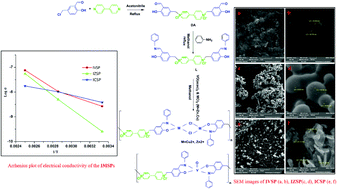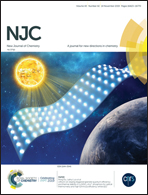Synthesis, characterization and solid state conductivity of nano-size ionic Schiff base polymers of Cu2+, Zn2+ and VO2+ containing viologen moieties†
Abstract
A new Schiff base ligand of bis (phenyl imino methylene salicylate) bipyridinium dichloride (L) was synthesized by reaction of bis (methylene salicylate) bipyridinium dichloride (DA) and phenyl amine in methanol under reflux conditions. New nano size ionic metallo-Schiff base polymers (IMSPs) were synthesized by reaction of the Schiff base ligand L and VO(acac)2, ZnCl2 and CuCl2 in separate reactions. The ligand and complexes were characterized by different spectral and analytical techniques. The chemical composition and functional group identification of the synthesized compounds were confirmed by CHN analysis, and FT-IR and 1HNMR spectroscopy. The thermal behaviour of the ligand and polymers was studied by TGA analysis. The molecular weight of the IMSPs was determined by gel permeation chromatography (GPC). In addition, the XRD, SEM and TEM methods were used to study the crystallinity, morphology and size of the polymeric Schiff base complexes and the results reflected the nano-size of the IMSPs. The solid state conductivity of the IMSPs was studied and the results showed a moderate conductivity of 2.66 × 10−9 to 2.55 × 10−10 Ohm−1 cm−1, which classifies them as metallo-polymer semiconductors.



 Please wait while we load your content...
Please wait while we load your content...